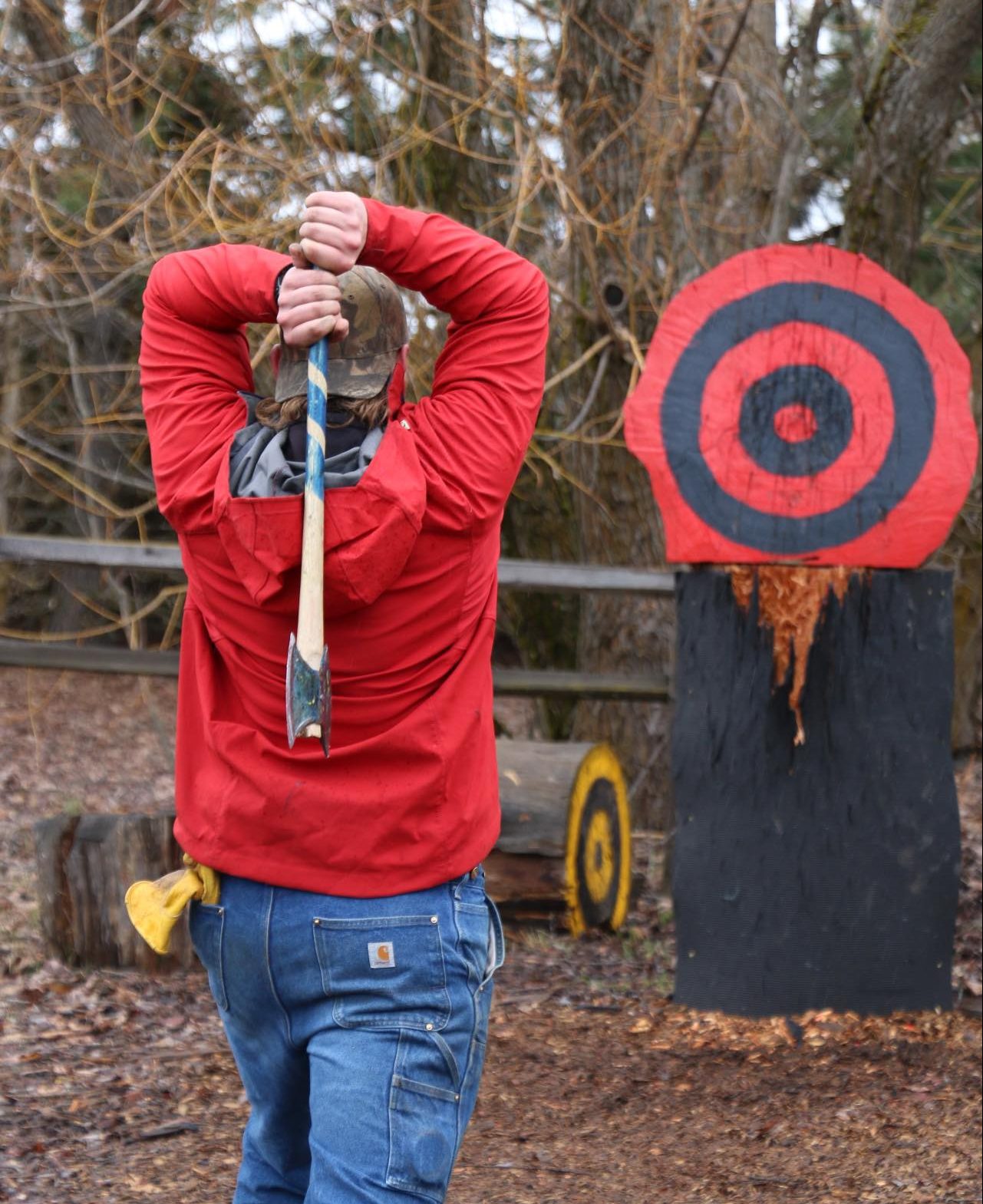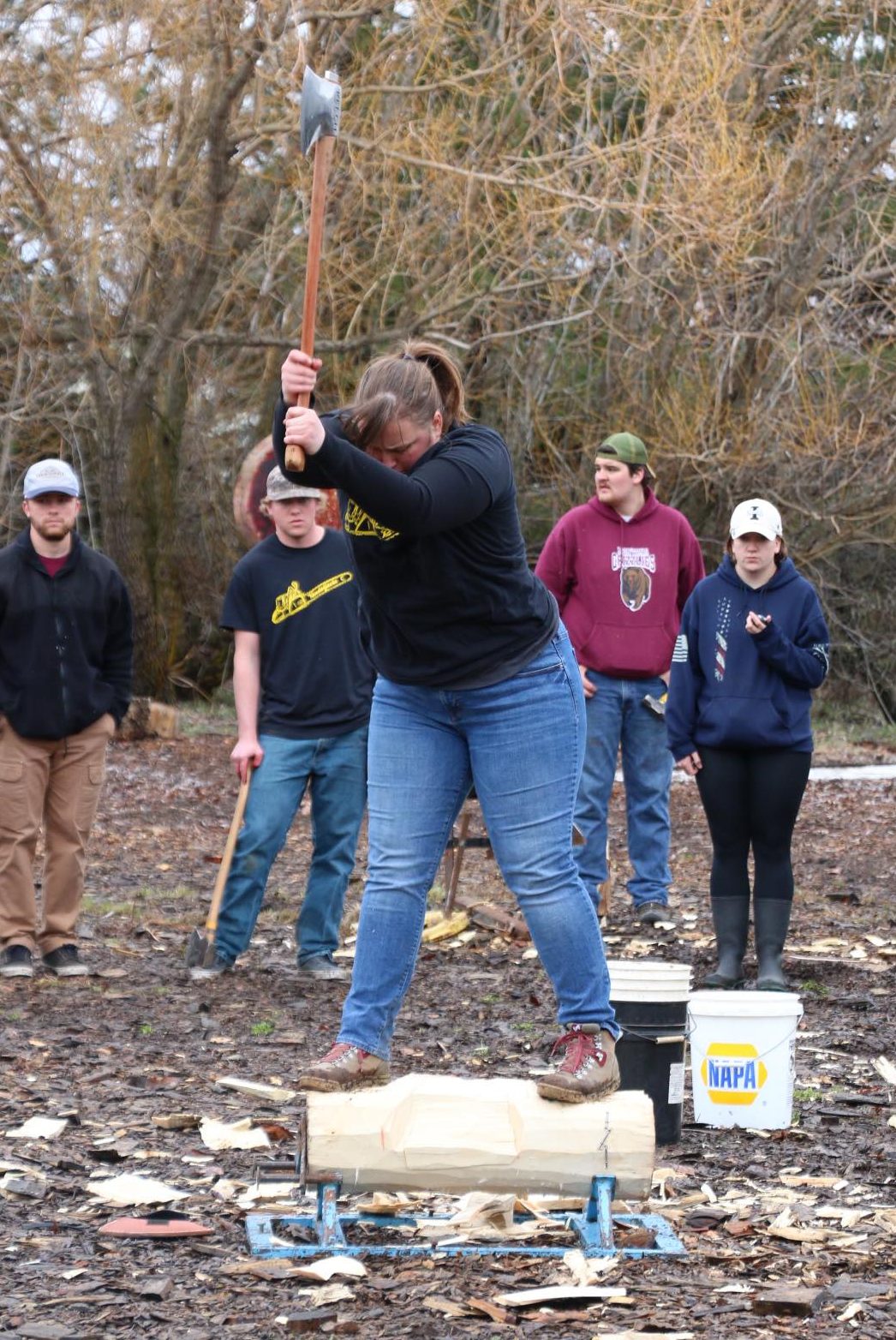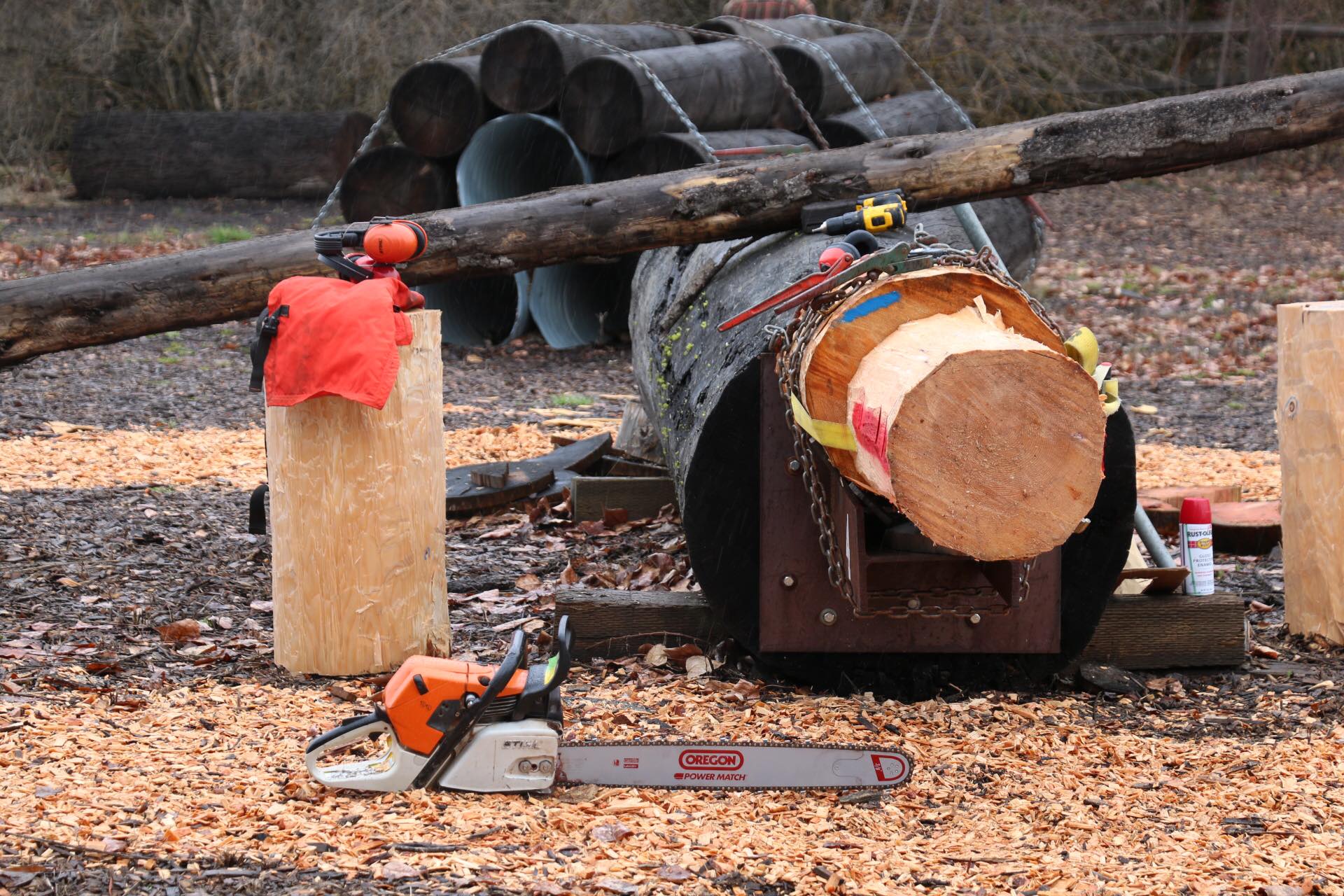On firm Moscow soil, Paul Riebe stands poised and ready with a chain saw in hand.
As the timer starts, Riebe sprints around a log balanced precariously with one end pointing to the Palouse sky. He begins his careful yet urgent ascent up the makeshift obstacle course, constructed to resemble a see-saw with the bottom end planted firmly in the ground.
At the top of the pole, Riebe is expected to drop-start his saw, using a single hand to throw the bladed machine away from his body. But before he even gets a chance, his foot — along with most of his body weight — lands on the end of the skyward bound log.
The single screw holding the tip of the already severed log gives way. Riebe and the saw both spin wildly through the air.
His hands are sliced on the log and Riebe’s midsection takes a beating. But it is all part of the job for the captain of the University of Idaho logger sports club.
“If I was worried about it, then I probably wouldn’t be doing it,” Riebe said.
Rooted in history
The idea of logger sports, Riebe said, is a simple one. Born straight out of the industry, logger sports began as most games often do — an argument.
“A dispute arose and that evolved into who was the best axe man or the best sawyer,” he said. “They agreed to settle it on even terms, and all of a sudden it wasn’t just about them anymore.”
Logger sports and the many techniques utilized during Saturday practices and occasional competitions serve as a snapshot of an industry on the decline, he said. Members of the club saw away at the many blocks of cottonwood off U.S. Highway 8 near the university’s Pitkin Forest Nursery, keeping the longstanding traditions of logging alive — despite the dropping number of forests actually being cut across Idaho and beyond.
Since the late 1990s and early 2000s, according to the United States Department of Agriculture, America’s consumption of timber has sharply decreased. With the rise of the internet and computer industry, as well as increased concerns surrounding endangered species and environmental protection concerns, the country’s need for loggers has fallen.
Adam Sowards, a UI professor and director of Pacific Northwest studies, said the industry found its way to Idaho and its surrounding states at the dawn of the 20th century. After the northern Midwest became over harvested, sections of land resembling a checkerboard pattern were sold to different private logging organizations or were designated to the federal government.
“The U.S. Government gave land to railroad companies, so they would build rail lines across the country,” Sowards said. “Railroads often sold their land to timber companies, so that’s what happened here in the Northwest and northern Idaho.”
But as the industry took a hit nearly 100 years later, logger sports became the premier place for those not heavily invested in the practice to witness the sheer physical skill it takes to succeed as a logger.
Testing grit and skill
Riebe and the six logger athletes who frequent Saturday morning practices set their sights on multiple events testing the grit and skill of those not directly involved in the industry.
Competitors partake in vertical chopping contests, where contenders stand atop a block — or log — and chop down beneath their feet. Events such as this can be measured by either the number of hits it takes to split the wood or the amount of time to do such.
Loggers can also chop horizontally, as if felling a tree, or partake in the choker obstacle course. Runners take in hand a metal cable made for cinching around logs, which would be attached to a helicopter and air lifted out of the forest. With the cable, competitors race through tunnels, crawling over and under obstacles before fastening it around a log.
“My uncle, when he was a logger in high school, he used to be a choker setter and it was right after the Vietnam War,” Riebe said. “They had a lot of old helicopter pilots who had just gotten out of the war. The choker setters on the ground are kind of the grunts.”
Meanwhile, Kylie Reich said her specialty lies in the more grueling event — cross cutting. Competitors use a much longer saw, with wooden handles attached on either end, nicknamed the “misery whip.” In either pair of solo events, competitors use nothing but their arms and torso to drag the saw across the log, attempting to shave off a “cookie” or small slice of the log.
“It’s pretty miserable. When you run it, you whip your body, so you have to have the right motion,” Reich said. “But it’s pretty miserable. Most people hate single bucking.”
![]() A dangerous game
A dangerous game
While Riebe said most competitors are fluent enough in the necessary skills to operate safely, accidents do happen.
Outside of Riebe’s run-in with the chain saw, he and Reich have both witnessed serious accidents during competitions at other schools.
Riebe said he witnessed a woman slip in a much similar way as him, also on the obstacle pole. However, her fall proved to be much more life-threatening.
“I heard a story about a girl that fell off the pole, lost her balance and she let go of the wrong part of the saw,” he said. “She let go with her left hand but held on to the trigger. She’s pinwheeling off the pole with a full RPM saw.”
Luckily, Riebe said, no one was hurt. Reich, meanwhile, said she witnessed a male competitor prepping a block for a vertical chop. While swinging down between his feet, the extra sharp axe sliced right into his foot.
Necessary safety measures are taken by most who partake in the event, such as wearing socks made of chain mail or cleated shoes made to dig into the wood. However, these methods are not always fool-proof, as Reich said she too fell off the obstacle pole with chain saw in hand.
“You wear corked shoes that have spikes on them. I was in the wood pretty good. I started the chain saw, lost my balance, fell with a running chain saw in my hand,” she said. “I turned around and grabbed the pole, so I fell on my back. I knocked the wind out of myself, but besides that I was OK.”
Sustaining the culture
As the logging industry continues to decline, Riebe said those economic troubles have translated into the club’s inability to sustain many members. Just after he had earned the title of captain, Riebe said he faced the possibility of being the sole competitor for the club, which had been part of the UI community since 1902.
After a strong recruiting push in the fall, Riebe was able to secure enough members for a proper team. Now a UI graduate student, Reich was one of those members.
While the club focuses on competition and training on a week-to-week basis, members also try to create a positive impact in the Palouse community.
Riebe said the club cuts and sells chords of wood before the winter months hit Moscow.
The club also volunteers at the annual Orofino Lumberjack Days event, where the team helps clear the competition ground. In exchange, those hosting donate unused logs for the team to practice with.
And while the team gives back to the community, alumni who competed in years past help train the up-and-coming logger athletes.
Amanda Chenowith, a 2016 UI graduate, still spends the occasional Saturday with the team, helping set up for competitions.
Chenowith said she came to school with no idea she would ever become so enthralled in the logger sports world. But after a brief introduction, she was hooked.
After graduation, she took her talents to the big stage and now stands as the 32nd best competitor in the country and the single best in Idaho.
Chenowith said she plans to compete in the STIHL Timbersports Series, an event described by Riebe as the “World Series of logger sports.”
“I love it. This is how I got started. Might as well help those who need it,” she said. “To get good at this sport, you have to have an open mind. Just like any sport, you have to be teachable and coachable.”
Story by Brandon Hill
Photos by Leslie Kiebert
Photos by Cadence Moffitt

 A dangerous game
A dangerous game